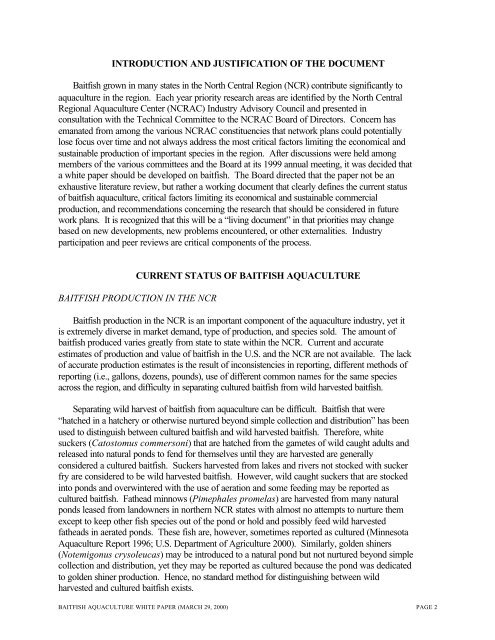a white paper on the status and needs of baitfish ... - NCRAC
a white paper on the status and needs of baitfish ... - NCRAC
a white paper on the status and needs of baitfish ... - NCRAC
Create successful ePaper yourself
Turn your PDF publications into a flip-book with our unique Google optimized e-Paper software.
INTRODUCTION AND JUSTIFICATION OF THE DOCUMENT<br />
Baitfish grown in many states in <strong>the</strong> North Central Regi<strong>on</strong> (NCR) c<strong>on</strong>tribute significantly to<br />
aquaculture in <strong>the</strong> regi<strong>on</strong>. Each year priority research areas are identified by <strong>the</strong> North Central<br />
Regi<strong>on</strong>al Aquaculture Center (<strong>NCRAC</strong>) Industry Advisory Council <strong>and</strong> presented in<br />
c<strong>on</strong>sultati<strong>on</strong> with <strong>the</strong> Technical Committee to <strong>the</strong> <strong>NCRAC</strong> Board <strong>of</strong> Directors. C<strong>on</strong>cern has<br />
emanated from am<strong>on</strong>g <strong>the</strong> various <strong>NCRAC</strong> c<strong>on</strong>stituencies that network plans could potentially<br />
lose focus over time <strong>and</strong> not always address <strong>the</strong> most critical factors limiting <strong>the</strong> ec<strong>on</strong>omical <strong>and</strong><br />
sustainable producti<strong>on</strong> <strong>of</strong> important species in <strong>the</strong> regi<strong>on</strong>. After discussi<strong>on</strong>s were held am<strong>on</strong>g<br />
members <strong>of</strong> <strong>the</strong> various committees <strong>and</strong> <strong>the</strong> Board at its 1999 annual meeting, it was decided that<br />
a <str<strong>on</strong>g>white</str<strong>on</strong>g> <str<strong>on</strong>g>paper</str<strong>on</strong>g> should be developed <strong>on</strong> <strong>baitfish</strong>. The Board directed that <strong>the</strong> <str<strong>on</strong>g>paper</str<strong>on</strong>g> not be an<br />
exhaustive literature review, but ra<strong>the</strong>r a working document that clearly defines <strong>the</strong> current <strong>status</strong><br />
<strong>of</strong> <strong>baitfish</strong> aquaculture, critical factors limiting its ec<strong>on</strong>omical <strong>and</strong> sustainable commercial<br />
producti<strong>on</strong>, <strong>and</strong> recommendati<strong>on</strong>s c<strong>on</strong>cerning <strong>the</strong> research that should be c<strong>on</strong>sidered in future<br />
work plans. It is recognized that this will be a “living document” in that priorities may change<br />
based <strong>on</strong> new developments, new problems encountered, or o<strong>the</strong>r externalities. Industry<br />
participati<strong>on</strong> <strong>and</strong> peer reviews are critical comp<strong>on</strong>ents <strong>of</strong> <strong>the</strong> process.<br />
CURRENT STATUS OF BAITFISH AQUACULTURE<br />
BAITFISH PRODUCTION IN THE NCR<br />
Baitfish producti<strong>on</strong> in <strong>the</strong> NCR is an important comp<strong>on</strong>ent <strong>of</strong> <strong>the</strong> aquaculture industry, yet it<br />
is extremely diverse in market dem<strong>and</strong>, type <strong>of</strong> producti<strong>on</strong>, <strong>and</strong> species sold. The amount <strong>of</strong><br />
<strong>baitfish</strong> produced varies greatly from state to state within <strong>the</strong> NCR. Current <strong>and</strong> accurate<br />
estimates <strong>of</strong> producti<strong>on</strong> <strong>and</strong> value <strong>of</strong> <strong>baitfish</strong> in <strong>the</strong> U.S. <strong>and</strong> <strong>the</strong> NCR are not available. The lack<br />
<strong>of</strong> accurate producti<strong>on</strong> estimates is <strong>the</strong> result <strong>of</strong> inc<strong>on</strong>sistencies in reporting, different methods <strong>of</strong><br />
reporting (i.e., gall<strong>on</strong>s, dozens, pounds), use <strong>of</strong> different comm<strong>on</strong> names for <strong>the</strong> same species<br />
across <strong>the</strong> regi<strong>on</strong>, <strong>and</strong> difficulty in separating cultured <strong>baitfish</strong> from wild harvested <strong>baitfish</strong>.<br />
Separating wild harvest <strong>of</strong> <strong>baitfish</strong> from aquaculture can be difficult. Baitfish that were<br />
“hatched in a hatchery or o<strong>the</strong>rwise nurtured bey<strong>on</strong>d simple collecti<strong>on</strong> <strong>and</strong> distributi<strong>on</strong>” has been<br />
used to distinguish between cultured <strong>baitfish</strong> <strong>and</strong> wild harvested <strong>baitfish</strong>. Therefore, <str<strong>on</strong>g>white</str<strong>on</strong>g><br />
suckers (Catostomus commers<strong>on</strong>i) that are hatched from <strong>the</strong> gametes <strong>of</strong> wild caught adults <strong>and</strong><br />
released into natural p<strong>on</strong>ds to fend for <strong>the</strong>mselves until <strong>the</strong>y are harvested are generally<br />
c<strong>on</strong>sidered a cultured <strong>baitfish</strong>. Suckers harvested from lakes <strong>and</strong> rivers not stocked with sucker<br />
fry are c<strong>on</strong>sidered to be wild harvested <strong>baitfish</strong>. However, wild caught suckers that are stocked<br />
into p<strong>on</strong>ds <strong>and</strong> overwintered with <strong>the</strong> use <strong>of</strong> aerati<strong>on</strong> <strong>and</strong> some feeding may be reported as<br />
cultured <strong>baitfish</strong>. Fa<strong>the</strong>ad minnows (Pimephales promelas) are harvested from many natural<br />
p<strong>on</strong>ds leased from l<strong>and</strong>owners in nor<strong>the</strong>rn NCR states with almost no attempts to nurture <strong>the</strong>m<br />
except to keep o<strong>the</strong>r fish species out <strong>of</strong> <strong>the</strong> p<strong>on</strong>d or hold <strong>and</strong> possibly feed wild harvested<br />
fa<strong>the</strong>ads in aerated p<strong>on</strong>ds. These fish are, however, sometimes reported as cultured (Minnesota<br />
Aquaculture Report 1996; U.S. Department <strong>of</strong> Agriculture 2000). Similarly, golden shiners<br />
(Notemig<strong>on</strong>us crysoleucas) may be introduced to a natural p<strong>on</strong>d but not nurtured bey<strong>on</strong>d simple<br />
collecti<strong>on</strong> <strong>and</strong> distributi<strong>on</strong>, yet <strong>the</strong>y may be reported as cultured because <strong>the</strong> p<strong>on</strong>d was dedicated<br />
to golden shiner producti<strong>on</strong>. Hence, no st<strong>and</strong>ard method for distinguishing between wild<br />
harvested <strong>and</strong> cultured <strong>baitfish</strong> exists.<br />
BAITFISH AQUACULTURE WHITE PAPER (MARCH 29, 2000) PAGE 2


